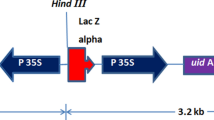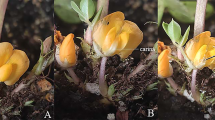Abstract
The biolistic method is reliable for delivering genes of interest into various species, but low transformation efficiency can be a limiting factor in its application. To test various conditions that could improve peanut transformation via particle bombardment, embryogenic tissues of the peanut cultivar Georgia Green were co-bombarded with two plasmids: one containing a green fluorescent protein gene and one containing a gene of interest plus a selectable marker. The fluorescence in bombarded embryogenic tissues was measured to evaluate transformation efficiency. A 4.6-fold improvement of transformation efficiency was achieved in stably transformed peanut lines by introducing protamine instead of conventional spermidine in a bombardment mixture with 70 ng/shot plasmid DNA and 50 μg/shot gold. Unexpectedly, the reduction of plasmid DNA from 700 to 70 ng/shot produced transgenic lines with significantly increased numbers of transgene copies. To determine the transgene copy number during plantlet regeneration, relative quantitative real-time polymerase chain reaction (qPCR) was established using fluorescently labeled universal library probes. A correlation of 95% was found for estimation of copy number between Southern blot and qPCR data. Given its speed and high-throughput nature, qPCR can be employed as an effective screening tool to separate high copy number events from low copy number events as early as the shoot formation stage of regeneration.






Similar content being viewed by others
References
Altpeter F, Baisakh N, Beachy R, Bock R, Capell T, Christou P, Daniell H, Datta K, Datta S, Dix PJ, Fauquet C, Huang N, Kohli A, Mooibroek H, Nicholson L, Nguyen TT, Nugent G, Raemakers K, Romano A, Somers DA, Stoger E, Taylor N, Visser R (2005) Particle bombardment and the genetic enhancement of crops: myths and realities. Mol Breed 15:305–327
Anuradha TS, Jami SK, Datla RS, Kirti PB (2006) Genetic transformation of peanut (Arachis hypogaea L.) using cotyledonary node as explant and a promoterless gus::nptII fusion gene based vector. J Biosci 31:235–246
Athmaram TN, Bali G, Devaiah KM (2006) Integration and expression of Bluetongue VP2 gene in somatic embryos of peanut through particle bombardment method. Vaccine 24:2994–3000
Bhatnagar-Mathur P, Devi MJ, Reddy DS, Lavanya M, Vadez V, Serraj R, Yamaguchi-Shinozaki K, Sharma KK (2007) Stress-inducible expression of At DREB1A in transgenic peanut (Arachis hypogaea L.) increases transpiration efficiency under water-limiting conditions. Plant Cell Rep 26:2071–2082
Bubner B, Baldwin IT (2004) Use of real-time PCR for determining copy number and zygosity in transgenic plants. Plant Cell Rep 23:263–271
Chu Y, Deng XY, Faustinelli P, Ozias-Akins P (2008a) Bcl-xL transformed peanut (Arachis hypogaea L.) exhibits paraquat tolerance. Plant Cell Rep 27:85–92
Chu Y, Faustinelli P, Ramos ML, Hajduch M, Thelen JJ, Maleki SJ, Ozias-Akins P (2008b) Reduction of IgE binding and non-promotion of Aspergillus flavus fungal growth by simultaneously silencing Ara h2 and Ara h6 in peanut. J Agric Food Chem 56:11225–11233
Dorer DR, Henikoff S (1997) Transgene repeat arrays interact with distant heterochromatin and cause silencing in cis and trans. Genetics 147:1181–1190
Fleming GH, Olivares-Fuster O, Fatta De-Bosco S, Grosser JW (2000) An alternative method for the genetic transformation of sweet orange. In Vitro Cell Dev Biol 36:450–455
Fu X, Duc LT, Fontana S, Bong BB, Tinjuangjun P, Sudhakar D, Twyma RM, Christou P, Kohli A (2000) Linear transgene constructs lacking vector backbone sequences generate low-copy-number transgenic plants with simple integration patterns. Transgenic Res 9:11–19
Gadaleta A, Giancaspro A, Cardone MF, Blanco A (2011) Real-time PCR for the detection of precise transgene copy number in durum wheat. Cell Mol Biol Lett 16:652–668
Garrick D, Fiering S, Martin DIK, Whitelaw E (1998) Repeat-induced gene silencing in mammals. Nat Genet 18:56–59
Gelvin SB (2003) Agrobacterium-mediated plant transformation: the biology behind the "gene-jockeying" tool. Microbiol Mol Biol Rev 67:16–37
Huang JM, Nandi S, Wu L, Yalda D, Bartley G, Rodriguez R, Lonnerdal B, Huang N (2002) Expression of natural antimicrobial human lysozyme in rice grains. Mol Breed 10:83–94
Iglesias VA, Moscone EA, Papp I, Neuhuber F, Michalowski S, Phelan T, Spiker S, Matzke M, Matzke AJ (1997) Molecular and cytogenetic analyses of stably and unstably expressed transgene loci in tobacco. Plant Cell 9:1251–1264
Ingham DJ, Beer S, Money S, Hansen G (2001) Quantitative real-time PCR assay for determining transgene copy number in transformed plants. Biotech 31(132–134):136–140
Jackson SA, Zhang P, Chen WP, Phillips RL, Friebe B, Muthukrishnan S, Gill BS (2001) High-resolution structural analysis of biolistic transgene integration into the genome of wheat. Theor Appl Genet 103:56–62
Joshi M, Keith Pittman H, Haisch C, Verbanac K (2008) Real-time PCR to determine transgene copy number and to quantitate the biolocalization of adoptively transferred cells from EGFP-transgenic mice. Biotech 45:247–258
Klein TM, Wolf ED, Wu R, Sanford JC (1987) High-velocity microprojectiles for delivering nucleic acids into living cells. Nature 327:70–73
Klein TM, Kornstein L, Sanford JC, Fromm ME (1989) Genetic transformation of maize cells by particle bombardment. Plant Physiol 91:440–444
Li Z, Jarret RL, Demski JW (1997) Engineered resistance to tomato spotted wilt virus in transgenic peanut expressing the viral nucleocapsid gene. Transgenic Res 6:297–305
Livak KJ, Schmittgen TD (2001) Analysis of relative gene expression data using real-time quantitative PCR and the 2(−Delta Delta C(T)) Method. Method 25:402–408
Livingstone DM, Birch RG (1999) Efficient transformation and regeneration of diverse cultivars of peanut (Arachis hypogaea L.) by particle bombardment into embryogenic callus produced from mature seeds. Mol Breed 5:43–51
Livingstone DM, Hampton JL, Phipps PM, Grabau EA (2005) Enhancing resistance to Sclerotinia minor in peanut by expressing a barley oxalate oxidase gene. Plant Physiol 137:1354–1362
Lowe BA, Shiva Prakash N, Way M, Mann MT, Spencer TM, Boddupalli RS (2009) Enhanced single copy integration events in corn via particle bombardment using low quantities of DNA. Transgenic Res 18:831–840
Magbanua ZV, Wilde HD, Roberts JK, Chowdhury K, Abad J, Moyer JM, Wetzstein HY, Parrott WA (2000) Field resistance to tomato spotted wilt virus in transgenic peanut (Arachis hypogaea L.) expressing an antisense nucleocapsid gene sequence. Mol Breed 6:227–236
Matzke MA, Moscone EA, Park YD, Papp I, Oberkofler H, Neuhuber F, Matzke AJ (1994) Inheritance and expression of a transgene insert in an aneuploid tobacco line. Mol Gen Genet 245:471–485
McKently A, Moore G, Doostdar H, Niedz R (1995) Agrobacterium-mediated transformation of peanut (Arachis hypogaea L.) embryo axes and the development of transgenic plants. Plant Cell Rep 14:699–703
Omar AA, Dekkers MG, Graham JH, Grosser JW (2008) Estimation of transgene copy number in transformed citrus plants by quantitative multiplex real-time PCR. Biotechnol Prog 24:1241–1248
Ozias-Akins P, Gill R (2001) Progress in the development of tissue culture and transformation methods applicable to the production of transgenic peanut. Peanut Sci 28:123–131
Ozias-Akins P, Anderson WF, Holbrook CC (1992) Somatic embryogenesis in Arachis hypogaea L.: genotype comparison. Plant Sci 83:103–111
Ozias-Akins P, Schnall JA, Anderson WF, Singsit C, Clemente T, Adang MJ, Weissinger AK (1993) Regeneration of transgenic peanut plants from stably transformed embryogenic callus. Plant Sci 93:185–194
Popelka JC, Xu J, Altpeter F (2003) Generation of rye (Secale cereale L.) plants with low transgene copy number after biolistic gene transfer and production of instantly marker-free transgenic rye. Transgenic Res 12:587–596
Prior FA, Tackaberry ES, Aubin RA, Casley WL (2006) Accurate determination of zygosity in transgenic rice by real-time PCR does not require standard curves or efficiency correction. Transgenic Res 15:261–265
Rohini VK, Sankara Rao K (2001) Transformation of peanut (Arachis hypogaea L.) with tobacco chitinase gene: variable response of transformants to leaf spot disease. Plant Sci 160:889–898
Schmidt MA, Parrott WA (2001) Quantitative detection of transgenes in soybean [Glycine max (L.) Merrill] and peanut (Arachis hypogaea L.) by real-time polymerase chain reaction. Plant Cell Rep 20:422–428
Sharma KK, Anjaiah V (2000) An efficient method for the production of transgenic plants of peanut (Arachis hypogaea L.) through Agrobacterium tumefaciens-mediated genetic transformation. Plant Sci 159:7–19
Sharma AD, Gill PK, Singh P (2002) DNA isolation from dry and fresh samples of polysaccharide-rich plants. Plant Mol Biol Rep 20:415a–415f
Shou H, Frame BR, Whitham SA, Wang K (2004) Assessment of transgenic maize events produced by particle bombardment or Agrobacterium-mediated transformation. Mol Breed 13:201–208
Singsit C, Adang MJ, Lynch RL, Anderson WF, Wang AM, Cardineau G, Ozais-Akins P (1997) Expression of a Bacillus thuringiensis cryIA(c) gene in transgenic peanut plants and its efficacy against lesser cornstalk borer. Transgenic Res 6:169–176
Sivamani E, DeLong RK, Qu R (2009) Protamine-mediated DNA coating remarkably improves bombardment transformation efficiency in plant cells. Plant Cell Rep 28:213–221
Song P, Cai CQ, Skokut M, Kosegi BD, Petolino JF (2002) Quantitative real-time PCR as a screening tool for estimating transgene copy number in WHISKERS™-derived transgenic maize. Plant Cell Rep 20:948–954
Thomas TJ, Kulkarni GD, Greenfield NJ, Shirahata A, Thomas T (1996) Structural specificity effects of trivalent polyamine analogues on the stabilization and conformational plasticity of triplex DNA. Biochem J 319:591–599
Tiwari S, Mishra DK, Singh A, Singh PK, Tuli R (2008) Expression of a synthetic cry1EC gene for resistance against Spodoptera litura in transgenic peanut (Arachis hypogaea L.). Plant Cell Rep 27:1017–1025
Vain P, James A, Worland B, Snape W (2002) Transgene behaviour across two generations in a large random population of transgenic rice plants produced by particle bombardment. Theor Appl Genet 105:878–889
Wang A, Fan H, Singsit C, Ozias-Akins P (1998) Transformation of peanut with a soybean vspB promoter-uidA chimeric gene. I. Optimization of a transformation system and analysis of GUS expression in primary transgenic tissues and plants. Physiol Plant 102:38–48
Xin Z, Velten JP, Oliver ML, Burke JJ (2003) High-throughput DNA extraction method suitable for PCR. Biotech 34(820–824):826
Yang H, Singsit C, Wang A, Gonsalves D, Ozias-Akins P (1998) Transgenic peanut plants containing a nucleocapsid protein gene of tomato spotted wilt virus show divergent levels of gene expression. Plant Cell Rep 17:693–699
Yang H, Nairn J, Ozias-Akins P (2003) Transformation of peanut using a modified bacterial mercuric ion reductase gene driven by an actin promoter from Arabidopsis thaliana. J Plant Physiol 160:945–952
Yang CY, Chen SY, Duan GC (2011) Transgenic peanut (Arachis hypogaea L.) expressing the urease subunit B gene of Helicobacter pylori. Curr Microbiol 63:387–391
Yi CX, Zhang J, Chan KM, Liu XK, Hong Y (2008) Quantitative real-time PCR assay to detect transgene copy number in cotton (Gossypium hirsutum). Anal Biochem 375:150–152
Acknowledgments
The authors thank Evelyn Morgan for technical support, Joe Nairn, Warnell School of Forestry Resources, UGA for the phaseolin promoter construct, and reviewers and editors for their valuable revision suggestions. This research was supported by the Consortium for Plant Biotechnology Research and the Peanut Foundation.
Author information
Authors and Affiliations
Corresponding author
Additional information
Editor: Ted Klein
Rights and permissions
About this article
Cite this article
Chu, Y., Bhattacharya, A., Wu, C. et al. Improvement of peanut (Arachis hypogaea L.) transformation efficiency and determination of transgene copy number by relative quantitative real-time PCR. In Vitro Cell.Dev.Biol.-Plant 49, 266–275 (2013). https://doi.org/10.1007/s11627-013-9518-8
Received:
Accepted:
Published:
Issue Date:
DOI: https://doi.org/10.1007/s11627-013-9518-8




